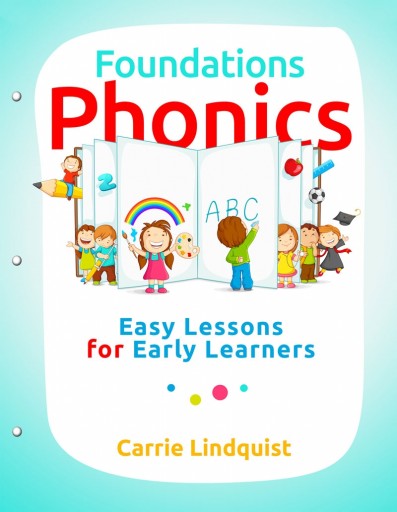Foundations Phonics is a gentle and lightweight introduction to phonics and reading, doubling as introductory Bible lessons. It is intended for use with kindergarteners or first graders who already know the names of letters and can easily recognize them.
The course teaches the sounds of the letters, including both short and long vowels plus some digraphs such as th, ch, ou, and ea. If children have sufficient fine motor coordination, Foundations Phonics can be used to teach printing. If children are not yet ready, they can still trace the shapes of letters with their fingers and complete other activities that help familiarize them with the way letters are formed.
I describe this as a lightweight introduction to phonics and reading because the pacing and intensity seem more like what you find in a kindergarten level program than in programs for first grade. Lessons are intended to be taught three days per week, for 20 to 30 minutes per day. On the other two school days, the lesson plans recommend that you use the bonus activities (described below), read aloud to your child, and practice with flashcards (that you will create on your own). Following such a schedule, you can complete the book in one semester. However, if you are using it with a kindergartner, you might spread things out a bit more, moving more slowly through the lessons so that children have plenty of time to learn each concept. A suggested daily schedule and a progress chart at the front of the book make it easy to keep track of where you are in the course and what comes next.
While Foundations Phonics teaches the sounds of letters, and how to blend sounds to make words, it also teaches a lengthy list of sight words, many of which are pronounceable phonetically once children learn their sounds. Thus in the second week, parents will begin adding sight words by teaching and and an. More sight words are taught each week–words such as is, it, if, did, the, that, this, and than.
The course is presented in an order unlike anything I’ve seen in other phonics courses. Three different sounds of the letter a are taught by the fifth week, even though students haven’t learned all of the consonant sounds. Mixing the instruction for both long- and short-vowel sounds (including macrons, breves, and Å) with instruction on consonants, vowel digraphs, and consonant digraphs might overwhelm some children with too much information too quickly. On the other hand, if you teach these lessons without expecting mastery, you can lay the groundwork for more thorough lessons to follow.
Each lesson is first presented with a biblical narrative. For example, as the lesson on page 111 begins, “M is for Moses–God saved Moses for a special mission.” The narrative tells a brief story about Moses, and there’s a map on page 114 that can be used for reference. Bold letters highlight the letters to be taught in that lesson. Both upper- and lower-case letters are taught at the same time. Children will then trace the letters "M" and "m" on their student page with their finger. On the next page, students practice reading individual words: mat, me, mast, Sam, jam, and same. This is followed by three short sentences including, “I sat and ate jam.” Words and sentences show diacritical marks over the vowels to assist students. However, it might not be realistic to expect students to be able to read the sentences at this point, so you can assist them as needed.
Bonus activities for this and other lessons generally include some options for active learning. For example, for this lesson, one activity is, “Send student on a mission to find objects that start with the letter M!”
Next, students can color the letters that they have traced with their finger. A short list of sight words to practice is located at the bottom of that same page. Students ready to practice printing can then trace and copy upper- and lower-case "M’s" on the next page. Since the word maze starts with "m," there is a small maze at the end of the lesson for children to complete with either their finger or a pencil. Some lessons include drawing and coloring activities on student pages.
The softbound book is three-hole punched so that you can remove student activity pages and save them in a binder as you work through the lessons. Student activity pages are not perforated, so you will have to remove them carefully. You will not remove teaching presentation pages or the reading practice pages.
Hands-on activities under bonus activities are optional, but you will need to plan ahead to choose those you wish to do and obtain resources if they are not readily available. A materials list showing what might be needed for each week is on pages 11 and 12. Examples of items listed are finger paint, construction paper, cookie sheet, shaving cream, pool noodle, building blocks with letters, playdough, marshmallow, and a toy car.
Aside from bonus activities, Foundations Phonics is easy to use without prior lesson preparation. Parents can read directly from the book, stopping whenever it says to “Allow students to answer” or gives other instructions for interaction.










